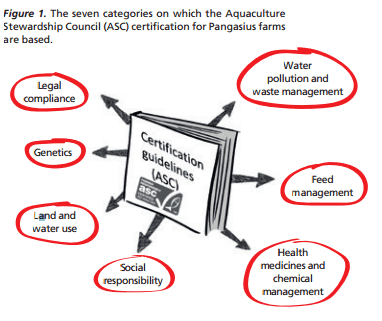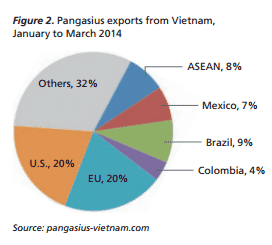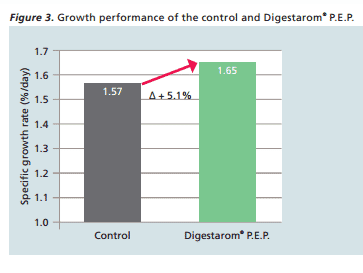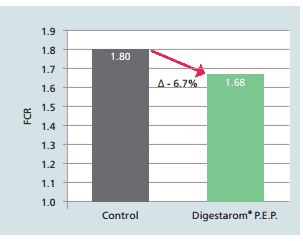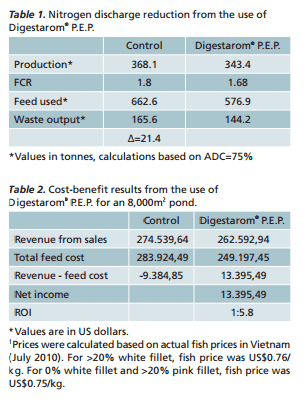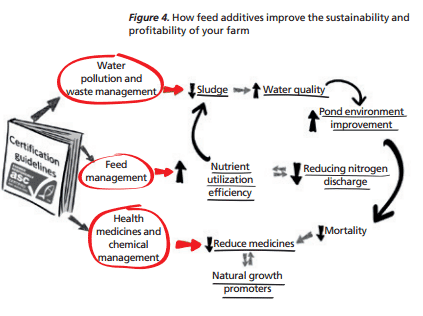One of the most widely used certification programs the Aquaculture Stewardship Council (ASC) is based on seven main categories (Figure 1). Of these, three important categories relate to feed efficiency, waste management and disease control. Within these topics, certification bodies have established specific targets in terms of feed conversion ratio (FCR), waste discharges and water pollution, and the use of medicines as prophylactic measures. These targets present challenges that farmers must face in order to comply with such certification.
Certification Has its Benefits
Farmers are also aware that by complying with such targets, sustainability certification can offer a premium price and allow exports to higher value markets. Feed additives can be used as a tool for feed mill integrators and farmers to achieve the demanding targets imposed by certification organizations. The use of organics acids, phytogenics, pre- and probiotics, as well as mycotoxin management, can help theaquaculture industry accomplish some of the requirements for certification process without any profit loss.
Case study: Pangasius catfish Vietnam is the source of more than 90% of the world’s supply of pangasius (Pangasionodon hypophthalmus). In the first three months of 2014, Vietnamese pangasius was exported to 126 markets.
The US is the biggest market with a total export value of $83.7 million, followed closely by Europe at $82.8 million. To maintain these numbers and export to international markets, catfish production in Vietnam needs to accomplish international quality certification patterns.
Improving feed efficiency
Phytogenics are known to stimulate digestive secretions, increase villi length and density and increase mucous production through an increase in the number of globlet cells. As a result, phytogenics improve feed digestibility. Several trials were performed with pangasius to confirm the efficacy of the Digestarom® P.E.P. product line in improving feed efficiency.
In a trial performed under commercial production conditions at Hung Ca farm in the Mekong Delta, two 8,000m2 ponds were stocked and the fish raised to a fi nal weight of 1.1kg. Dietary supplementation with Digestarom® P.E.P. led to 5.1% higher specific growth rate (SGR) and 6.7% lower FCR (Figure 3). Nutrient utilization improved as FCR became more efficient. Through enhanced FCR, farmers could achieve one of the most important requirements for the certifcation programme—nutrient utilization efficiency. Th is improvement also has direct positive effects on feed cost, water quality and nitrogen discharge.
Reducing Nitrogen Discharge
Through improved protein utilization, phytogenic feed additives can also decrease ammonia emissions and organic matter discharge. Considering a 6.7% reduction in FCR and assuming an average apparent dry matter digestibility coefficient (ADC) of 75%, the reduction in waste output to the environment would be 21.4 tonnes (Table 1).
Sustainability is Profitable
It is estimated that feed costs in Vietnam are about 80% of total production costs. It therefore stands to reason that if we could reduce the feed given but produce the same quantity of fish, we could increase profits while limiting nitrogen discharge. On this trial, improvement in fillet colour allowed the fish supplemented with Digestarom® P.E.P. to be sold at US$0.76/kg instead of US$0.75/kg (prices in July 2010, Vietnam). Th e 6.7% reduction in FCR also helped the farmer reduce feeding costs. Finally, we could conclude that the inclusion of Digestarom® P.E.P. resulted in a total extra revenue of US$10,046 per 8,000m2 pond, and a return of investment (ROI) of 1:5.8. This does not even consider the premium price that farmers can receive if production is certifi ed. Th rough phytogenics nutrient utilization efficiency is improved, directly reducing feed costs and nitrogen discharge. Improved nutrient sparing also reduces the impact on the environment, leading to improved water quality, pond eco-system and better sludge control. Farmers also gain the benefi t of a higher quality fillet.
Prophylactic Antibiotic Replacements
Acidifiers can act in the intestinal tract to reduce pH-levels in the stomach and particularly in the small intestine, inhibiting the growth of Gram-negative bacteria through the dissociation of acids and production of anions in the bacterial cells. Acidifiers also act as preserving agents by reducing the pH of feed, and thereby inhibiting microbial growth. Several aquaculture trials performed with the Biotronic® product line show that through the efficacy of these products as natural growth promoters, the use of antibiotic growth promoters can be totally dismissed. This fulfils one of the most important criteria for certification without any loss in growth performance. In addition, the decreased uptake of biological organisms through feed will improve the health status of cultured fish, reducing disease outbreaks without any need for veterinary medicines.
Tools for improved gut health
Preventing diseases is surely more cost effective than treating ill animals. Probiotics are able to modify the intestinal microbiota, secreting antibacterial substances (bacteriocins and organic acids) that compete with pathogens to prevent their adhesion to the intestine. Probiotics also compete with pathogens for the nutrients necessary for pathogen survival, producing an antitoxin effect. The use of AquaStar® Hatchery/Growout can improve the health status of aquatic animals by reducing diseases outbreaks and the need for veterinary medicines.
Pond management
Intensive fish farming produces large amounts of organic waste which accumulate in the pond bottom and cannot be utilized by the phytoplankton. Oxidation of these organic waste compounds depletes the dissolved oxygen deep in pond bottom soils, leading to the formation of toxic metabolites. This contributes greatly to deteriorating water quality and disease occurrences.
A useful and sustainable tool for managing the pond environment is the application of AquaStar® Pond/ PondZyme. This type of bioremediation uses selected strains that focus on reducing pathogenic bacteria, enhancing the mineralization or degradation of organic matter, and removing undesirable waste compounds. Despite not being therapeutic agents, these beneficial bacteria alter directly or indirectly the composition of the microbial community in the rearing environment, and consequently in the fish gut, improving animal health and performance.
Managing Mycotoxins in Feed
Preventing diseases and efficiency losses
Ingested mycotoxins may lead to an overall decline in performance which may ultimately result in economic losses. It is difficult to observe directly the negative effects of mycotoxins in aquaculture species as most of the symptoms of mycotoxicosis are subclinical and hard to detect. Several studies have highlighted the negative effects of mycotoxin-contaminated feeds in aquaculture. Some of these effects are reduced growth, increased production costs, overall negative effects on the pond eco-system, immune suppression and decreased disease resistance.
Symptoms of mycotoxicosis in aquatic species can pass unnoticed and economic losses are usually associated with diseases outbreaks rather than mycotoxins. Th e incorporation of Mycofi x® in aquafeed can help mitigate the negative eff ects of mycotoxins, mainly tissue damage, that can lead to poor growth performance and disease susceptibility. The use of feed additives through different strategies can help farmers achieve better aquaculture practices. This will enhance growth, survival and feed conversion rates, and increase tolerance to diseases, as well as better environmental conditions. Feed additives can support a more sustainable and profitable farm (Figure 2).
November 2014

